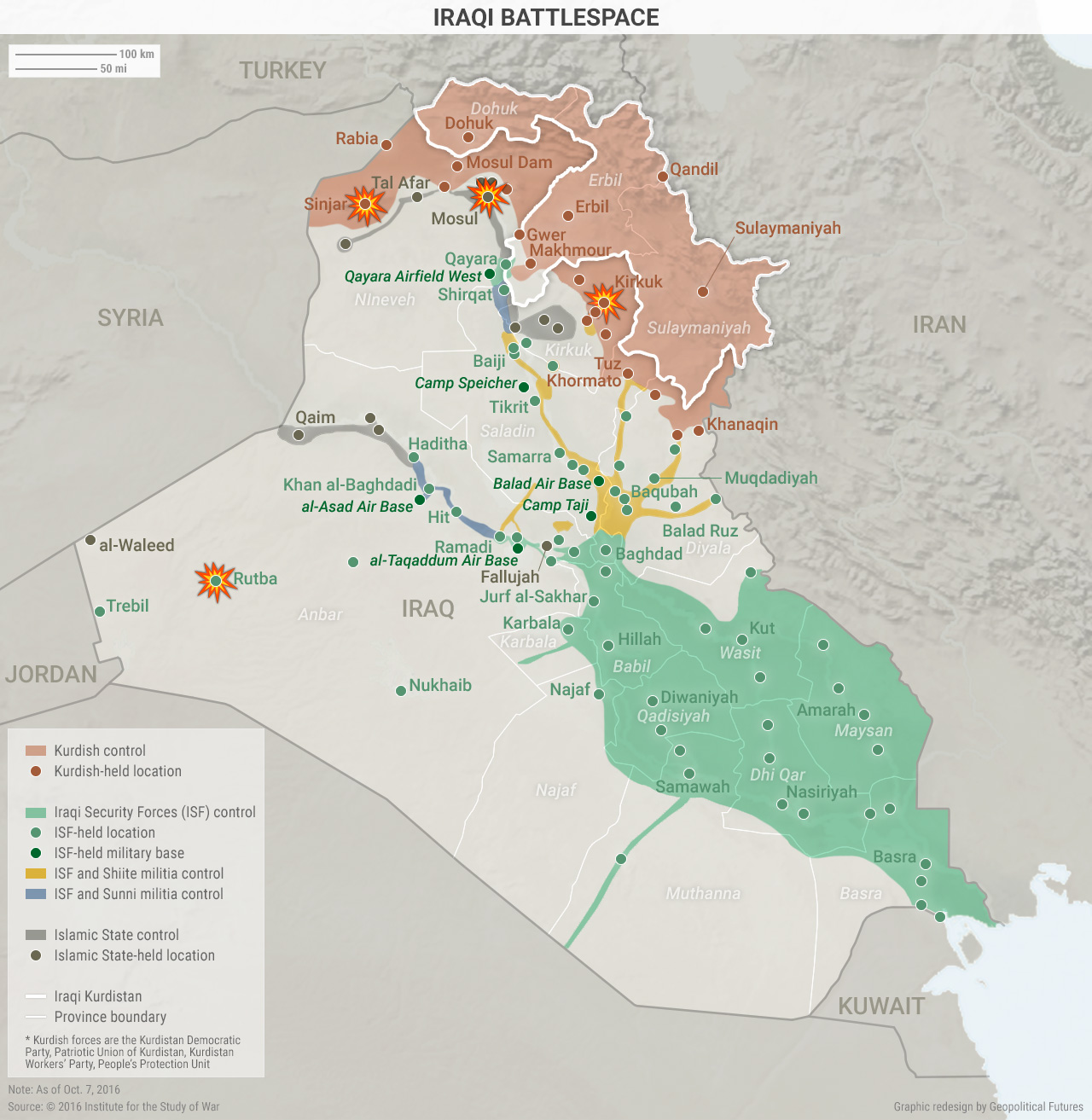Originally produced on Oct. 31, 2016 for Mauldin Economics, LLC
George Friedman and Jacob L. Shapiro
The Islamic State captured Iraq’s second largest city, Mosul, from the Iraqi government after a seven-day battle in June 2014. The US-backed Iraqi assault to recapture Mosul began with great fanfare on Oct. 18.
This piece will lay out the key things you need to know about the battle for Mosul in five maps.
But one thing cannot be expressed in maps. Already, the battle to take Mosul back has lasted longer than the battle IS fought to conquer it. IS is outmanned and outgunned in this fight, but it has dug in. It occupies a highly defensible position, and it is not going to retreat. This battle is not going to be a rout. It is going to be a bloody example of urban warfare.
The Battle for Mosul Begins
This map reveals three points about the coalition to retake Mosul. First, it shows how far Iraqi Security Forces and Kurdish peshmerga fighters have advanced. In the first few days, these fighters advanced quickly, until meeting stiffer Islamic State resistance roughly 10 to 25 miles outside the city. The coalition forces are still advancing, but their progress, especially approaching from the south, has been slowed significantly.
Second, it shows how far these forces have yet to go to reach the city—the battle will not begin in earnest until they do.
Third, it gives a sense of the anti-IS coalition’s strategy. Although there have been reports of Shiite militias heading west to cut off potential IS retreating points, those are unconfirmed at present, and the militias certainly don’t include the bulk of Iraq’s best fighters. The coalition is hoping that IS fighters will retreat from their positions and melt back into the desert, fleeing to their strongholds in Syria or becoming easy targets for airstrikes. IS is not likely to retreat—if it was going to, it would have done so already.
The second map in this series is a close-up satellite map of Mosul. Two key observations should be taken from this map.
First, you get a sense of just how messy this battle is going to be. Mosul is surrounded by the desert on most sides, and the fighting in the deserts and villages is going to pale in comparison to the fighting in the city once Iraqi troops enter. Mosul’s population is between 700,000 and 1.5 million. Every house and structure on this satellite map is a potential booby-trap, sniper’s den, or obstacle to an enemy’s advance.
Second, you can see how the battle is going to progress if it goes well for the coalition. Mosul is divided by the Tigris River. As Iraqi forces make progress coming from the south and east, IS will eventually retreat across the five bridges that link the two sides of the city. Those bridges will be major chokepoints, and IS could even opt to destroy them to slow the regime’s advance. Iraqi forces will be forced then to alter their approach to a siege and send troops around the other side or else take casualties in getting across those bridges.
This third map gives a better picture of how far Iraqi and Kurdish forces have advanced. It shows that while IS is in an advantageous position to fight an incoming attack, it has a much shakier position defending its supply lines. Though IS controls stretches of some of the major highways and roads, none of them lead to areas controlled by IS. Its only hope of resupply is through the vast swaths of desert to the southwest of the city. These supply lines are hard to interdict, but they also limit the amount of reinforcements IS can expect. This is one of the major reasons IS has thus far resorted to suicide bombs and booby-traps. We know IS has some major weaponry in Mosul, but it must conserve its ammunition.
This map also reveals that Mosul is the intersection of a number of major highways and roads. The major highways passing through the city link Mosul to Syria, Baghdad, Turkey, and even Iran. Mosul is a strategically important city, unlike many of the other small villages and areas IS has retreated from in the last year.
The Larger Battle Ahead
Our last map is not confined to Mosul but place the battle in a broader perspective. Mosul is an intersection not only between major highways in Iraq but also between cultures, religions, and even languages. Mosul represents the meeting point between Iraq’s two largest minority groups, the Kurds and the Sunni Arabs. There are also significant pockets of Turkomans in the city and nearby as well.
Mosul is majority Sunni, but it has historically been a diverse city. This is one of the reasons the city is so hard for any power to control. The Ottomans ruled Mosul once. And today, Turkey still feels a need to assert its interests there, maintaining unauthorized troops on the ground near Bashiqa. There was even a story last week about a Turkish official claiming that deeds of land ownership in Mosul from the Ottoman days might provide basis for future Turkish legal challenges in the city.
The Sunnis, suspicious of the Shiite-dominated government in Baghdad, have not embraced the Iraqi state since Saddam Hussein’s regime was deposed. The Kurds have been opportunistically grabbing as much territory as they can amid all the chaos. Adding Mosul would be a major coup for them. The battle for Mosul will not end even if IS is successfully beaten. There are many different competing interests and groups for whom Mosul is a sought-after prize.
This last map amplifies the point made above, showing the various groups that control parts of Iraq. It also shows how IS has fallen back on one of its classic tactics—carrying out attacks in other places to try and distract its enemy. Thus far, there have been major IS attacks in Sinjar, Kirkuk, and Rutba. IS even briefly held half of the town of Rutba before retreating. None of these attacks have yet proved decisive enough to force the coalition to pull back resources from the fight for Mosul.
But there are still areas in Iraq besides Mosul where IS can cause significant problems for the coalition, and we can expect such attacks in Iraq to increase as the battle for Mosul progresses. We also see that the sectarian issues that created the vacuum filled by IS have not gone away—they still define the Iraqi landscape today, and will continue to do so, no matter the result of the Iraqi forces’ advance on Mosul.
To sum up: the battle for Mosul is going to take a long time. It is going to be a bloody affair and a textbook example of urban warfare once Iraqi forces actually reach the city. IS is at a severe disadvantage in terms of the number of fighters and material, but IS is in a highly defensible position and has no place to retreat. The sectarian issues that plague Iraq as a whole have been put aside in an attempt to drive IS out. But if the coalition is successful, these sectarian issues will reassert themselves.
These maps are meant to illustrate how the battle for Mosul is progressing. They also drive home the point that Mosul is just one battle in a much larger war for which the outcome remains uncertain.












